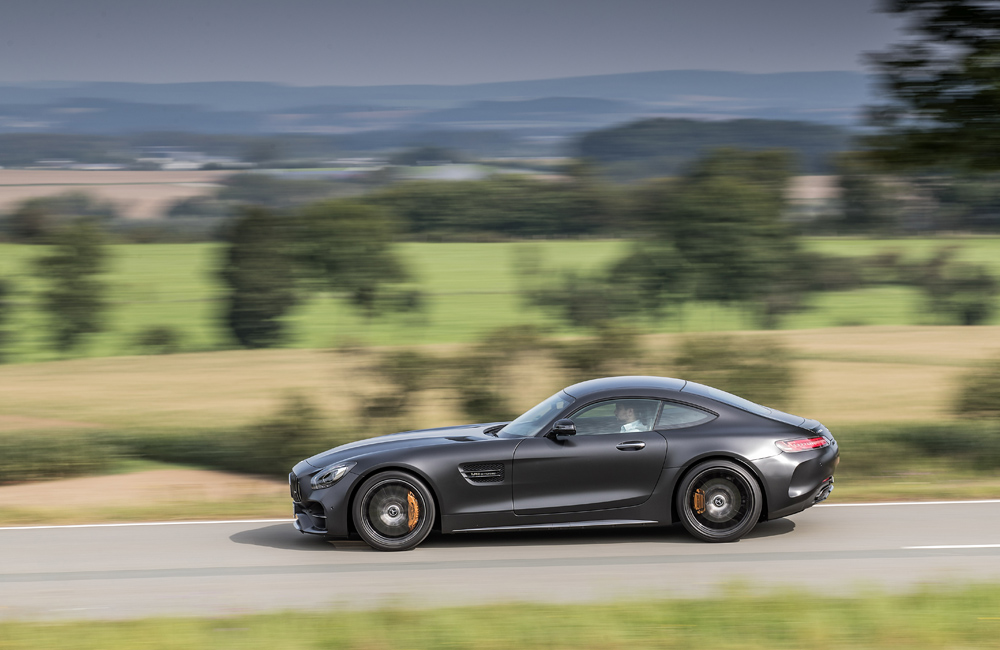PADERBORN, Germany – Judging by my experiences, the trust and respect Germans have for each other on the road are unparalleled around the world. For instance, we’re on the autobahn for only a few kilometres and the digital display is already indicating 170 km/h. The traffic clears and with a slight flex of my right foot I accelerate past 200 km/h, passing a truck in the slow lane doing less than 100 km/h. But there’s no fear of the truck moving into my lane.
Meet the GT C…
Yes, straight-line speed is part of the appeal of the new Mercedes-AMG GT C Coupé, the latest additional to the GT family. But there’s way more to it than that. Offering the same drivetrain as GT C Roadster, this model slots in between the AMG GT S and the bewinged, faster AMG GT R.
Bertram Tschamon, one of the engineers responsible for the engine’s development, explains that the C’s engine is actually based on the engine found in the R. Interestingly, the GT and GT S engines share the same hardware, while the GT C and GT R are closely related.
The main difference between the C’s engine and that of the more powerful R is engine calibration. The result is 410 kW and 680 N.m in the former, versus the R’s 430 kW and 700 N.m.
Obviously, there is also the exterior design. Some enthusiasts prefer a subtler alternative, and that is where the C steps in. It doesn’t feature the rear wing of the R nor the diffuser, while the front bumper is also closer to that found on the GT and GT S. The cabin is also slightly more luxurious with a little less carbon-fibre trim than is found in the R.
On the road
Climb in and like all AMG GTs, you are positioned close to the rear axle with the vented bonnet stretching out in front of you. You sit low to the ground and feel especially connected to the car through the supportive buckets seats. The Alcantara-clad steering wheel is another reminder that this car is actually pretty close to GT R.
Press the start button on the wide transmission tunnel and the exhaust system clears its throat with a deep burbling sound, together with several welcome pops and crackles. I turn the drive mode selector to Sport+ and switch the suspension setting to normal as the roads are a little wet in places.
I first play around in the 4 000– 5 000 r/min range. There is so much torque (maximum twisting force is available from as low as 1 900 r/min) that the in-gear acceleration surprises me. The crackles and bangs further encourage me to push on and the needle runs with a stronger urge to the 7 000 r/min red line before a large “3rd Up” appears on the digital screen in front of me. I pull the right-hand paddle and the surge simply continues.
The GT C, like the R, features rear-wheel steering that further contributes to sharp direction changes at low as well as higher speeds. As you sit so close to the rear axle it is relatively simple to sense what the rear of the car is doing, and at conjunctions or sharp turns it is easy to overpower the rear axle. But the moment the rear tyres regain grip you can confidently press the throttle and appreciate how the combination of torque and power propels you down the road.
Summary
The GT C is a pure sports car that slots in perfectly below the GT R. As these 500 Edition 50 models will first be sold, the standard models will only be heading for production around December, meaning that local pricing can’t be confirmed at this stage.
But, if we were to hazard a guess, we’d expect the GT C Coupé to cost around R200 000 less than the GT R; whatever way you look at it, both the GT R and GT C seem good value. However, if you want to move slightly under the radar, the GT C is a very smart proposition indeed.










